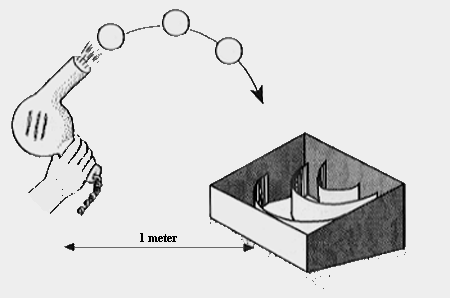


![]()

How does a jumbo jet get off the ground How can an airplane as heavy as three blue whales get off the ground? How does the wing design of a 747 allow a plane longer than the Statue of Liberty to fly?
Peggy discovers that jumbo jets,
which can weigh up to 870,000 lbs.,
are just as safe as smaller planes.
People have always wanted to fly. Leonardo da Vinci, who often dreamed about flight, drew intricate designs for several different flying machines. Among the many scientists whose discoveries made human flight a reality are Sir Isaac Newton (1642-1727) and Daniel Bernoulli (1700-1782). Both are credited with developing the scientific principles that explain how an airplane flies. However, it was not until many years later, on December 17, 1903, that Orville and Wilbur Wright actually applied these principles to successful airplane flight. Their first flight lasted only 12 seconds, and they traveled only 120 feet. The entire trip could have taken place inside of a 747.
Whether a single-seat propeller plane or a giant 747, there are four fundamental forces at work in airplanes. Thrust is the forward movement of the airplane, provided by the propellers or jet engines. Drag is the opposing force of the displaced air, the same force you feel walking into a strong wind. Gravity acts on the airplane, pulling it down toward the earth, and lift counteracts the force of gravity, keeping the airplane up in the air. The lift force is equal to the force of gravity when an airplane is in level flight.
Bernoulli's principle helps to explain lift. Bernoulli demonstrated that the faster a fluid moves, the less pressure it exerts. An airplane wing is shaped so that air (which is a fluid) moves faster over the top of the wing than it moves under the bottom of the wing. As a result, there is greater pressure underneath the wing than there is on the top of the wing, resulting in a net force which "lifts" the wing.
The angle at which the wing meets the air (the angle of attack) also contributes to lift. You can easily demonstrate this when you hold your hand out the window of a moving vehicle and change the angle at which your palm meets the oncoming air. If the surface of an airplane wing meets the air at an angle, the wing exerts a force on the air and the air exerts an equal force on the wing--an effect which Newton described in his third law of motion. There are many other factors that influence lift: the shape and area of the wing, the velocity of the airplane, and even the density of the air.
Pilots and aeronautical engineers use the forces involved in lift to help them design and fly planes of all sizes and shapes. With the right lift, even a 870,000-pound jumbo jet can head for the sky.
Additional sources of information
Community resources Local airport authority

With a stream of air and Bernoulli's principle, you will hold a ball in midair before hitting it into a target.
(also see the activity for Windsurfing: Show 1106) Challenge your friends to a game of Bernoulli Ball. The game looks easy, but you will quickly see that there are subtle forces at work which require shrewd analysis and manipulation for accurate shooting.
Materials
Questions

With the fingers of both hands, hold a single sheet of paper just below your lower lip. Allow the paper to bend and hang downward. Blow across the top surface of the paper. What happens? Explain, using Bernoulli's principle.
![]()
![]()
Find a Styrofoam ball about the size of a baseball. Play catch with a friend. Throw the ball in such a way that it spins. Try both a "top to bottom" spin and a "sideways" spin. What happens to the ball? Explain, using Bernoulli's principle.
![]()
![]()
Make an atomizer out of a soda straw. With a knife, slit the straw one-third of its length from one end. Bend the straw at the slit and place the short section into a glass of water. Make sure that the slit is no more than one centimeter above the surface of the water. Blow hard through the other end of the long section of the straw. What happens? Explain using Bernoulli's principle.
![]()
![]()
Tape a table-tennis ball to a string and allow the ball to swing into a stream of water running smoothly from a spigot. Lightly tug on the string by pulling it to the side. What happens to the ball? Explain, using Bernoulli's principle.
Tapes of this episode of Newton's Apple and others are available
from GPN for only $24.95.
Please call 1-800-228-4630.
For information on other Newton's Apple resources for home and school,
please call 1-800-588-NEWTON!
 We encourage duplication for educational
We encourage duplication for educational Newton's Apple is a production of KTCA Twin Cities Public Television.
Made possible by a grant from 3M.
Educational materials developed with the National Science Teachers Association.